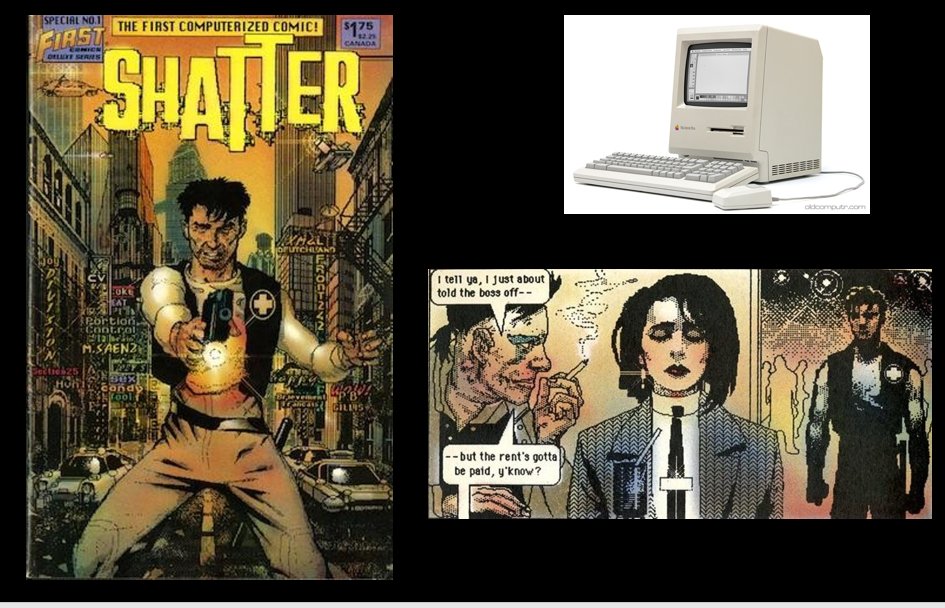Once upon a time, way back in 1985, an artist named Mike Saenz thought he could use his shiny new Macintosh Plus to draw comics. In MacPaint, a simple B&W paint program that predated the concept of “layers”. With a mouse. These B&W images then had what looked like watercolors overlaid on them to print the final, full-color comic. It looked something like this:

(image swiped from Ben Towle’s tweet regarding Shatter that inspired me to do this)
Narratively, it was a bunch of cyberpunk stuff. Saenz left after three issues, other artists worked in more traditional methods before scanning it into the Mac, adding tones, and printing it out for the signature look, until another person crazy enough to actually do it in the Mac (now with a slightly more sophisticated paint program, though still not one much more powerful than MSPaint, and a drawing tablet) came on board for the rest of its run.
It was amazing at the time. Cyberpunk! Made on a computer! SO COOL! Now, of course, it looks insanely retro.
Today I was reminded it existed, and wondered if I could get Illustrator to reproduce its signature look. A half hour later, I had this:

It ain’t perfect but it’s a pretty good start.
Mostly it relies on two effects:

First off, I’ve got a couple of layers that I’m doing some simple B&W art on. One layer’s got the lines and textures, the other’s got a bunch of translucent shapes.

These two layers are crammed into a layer, which has the halftone effect from Astute’s Phantasm plugin applied to it. This gives it that distinctive one-bit MacPaint look.

Below this, there’s a couple of layers for the foreground and background colors, which are also crammed into a layer. This one’s got a Gaussian blur to muck it up. (The white shapes are part of the ‘ink’ layers, and vanish in the final art because I’m telling the halftone plugin to render all of this as an overprint for that extra bit of Four-Color Comics Process authenticity.)

And also here is a quick 15-minute drawing of the Baron from Parallax using these effects. With some slightly different settings on the halftone plugin – Bayer dithering instead of Floyd-Steinberg, which does a better job on large areas of tone.
Now I kinda want to draw a goofy short cyberpunk comic this way. Probably just B&W with a little spot color here and there.
It’s a weird, cool look!
For what it’s worth, Saenz didn’t use MacPaint, he used his own program, ComicWorks which I had and used to make some comics back in ’86. It was a great program at the time, fit on one 400k disk and was WAY better than MacPaint because you could adjust the size and spatter of the spray can. At the time, it felt WAY punk. That and Fontographer were my two favorite early Mac programs and I used the hell out of them.
Well done on the replication! I’d say you got it down perfectly!
I was going by Wikipedia’s page on the comic, which says MacPaint. ComicWorks isn’t mentioned at all. Not that I 100% trust Wikipedia. :)
(Doing a little more research it looks like ComicWorks came out in 1986; Saenz’ last issue of Shatter came out in June ’86, and I’m sure he was using it earlier than that!)
—-
Thanks! I think there are a few things I could to to make it more precise, but a lot of them are really just down to “spending more then about ten minutes on the B&W art and actually making an attempt at a halfway decent drawing”. :)
It is kind of hilarious to think about how much CPU power is involved in simulating this low-res look. The source file for these two drawings is five point six megabytes.
I put the shotgun in an Adidas bag and padded it out with four pairs of tennis socks, not my style at all, but that was what I was aiming for: If they think you’re crude, go technical; if they think you’re technical, go crude. I’m a very technical boy. So I decided to get as crude as possible. These days, thought, you have to be pretty technical before you can even aspire to crudeness. – William Gibson, Johnny Mnemonic
God.. I was 15 and bough a copy of this just because it was “the first”.. Like many people I don’t think I got the second issue.